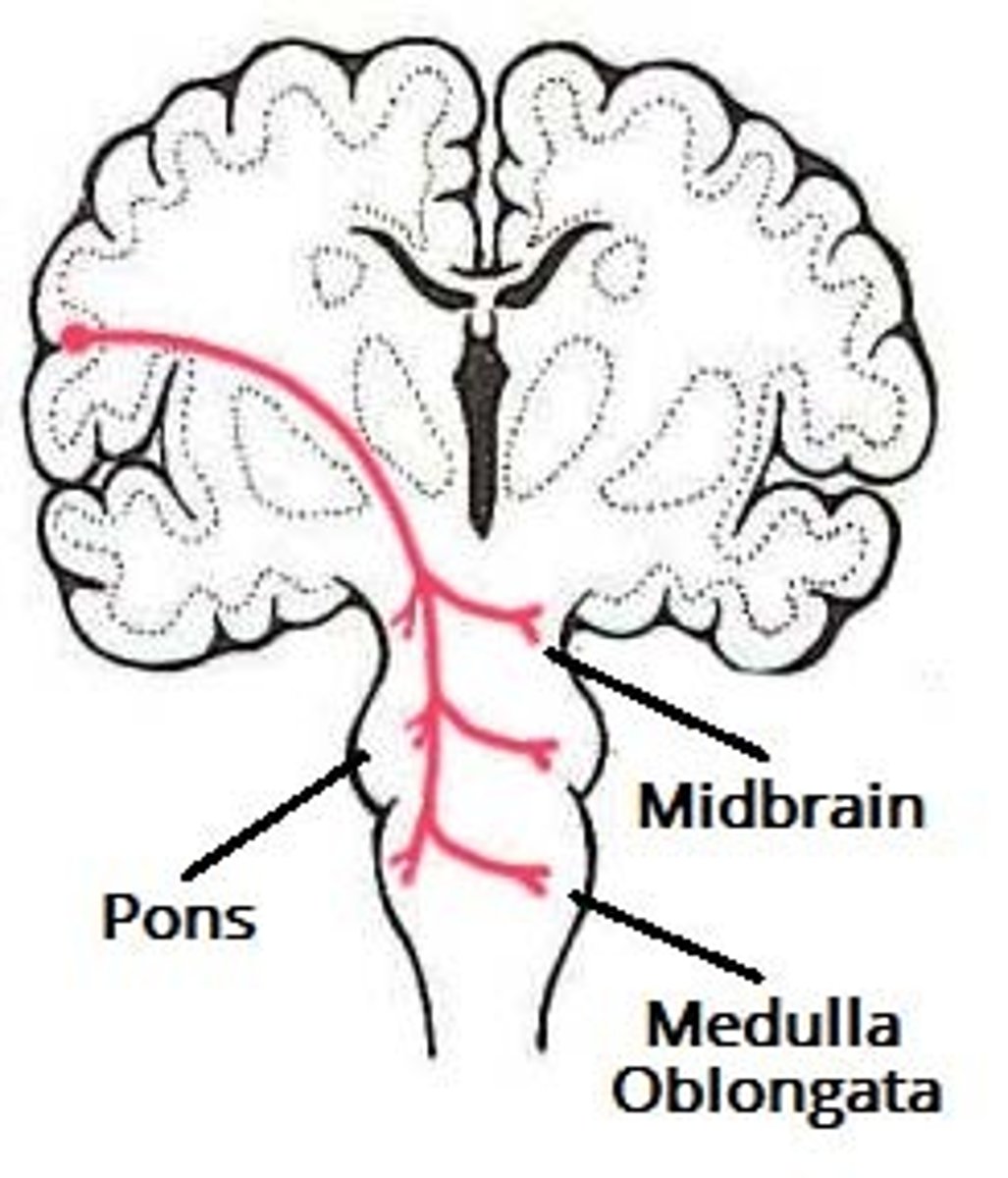Neurology For Exam 1
1/194
There's no tags or description
Looks like no tags are added yet.
Name | Mastery | Learn | Test | Matching | Spaced |
|---|
No study sessions yet.
195 Terms
What is the subcortex?
a term referring to all brain structures below the cerebral cortex
Where are the ventricles located?
in the subcortex
what many ventricles do we have
4 total
2-lateral
1-thirds that connects the two lateral onces
1-between the cerebellum and the brainsteam
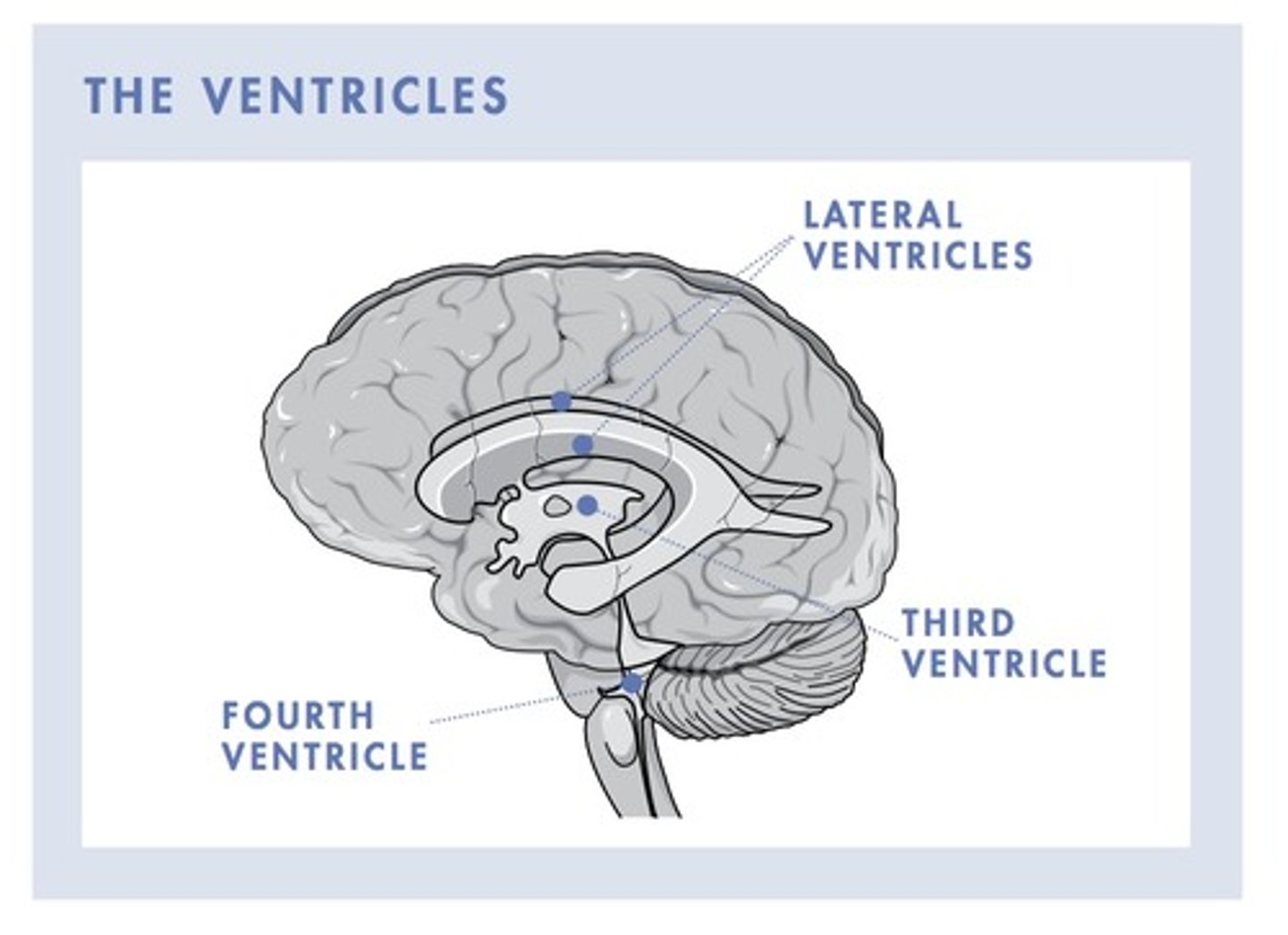
what are ventricles filled with
cerebrospinal fluid (CSF)
what is the 3 purposes of CSF
1) cushions the brain
2) delivers nutrients to the brain
3) removes waste products
where does CSF come from
it is produced by choroid plexus cells found in each ventricle
how much CSF do we produce a day
500 mL
where deos CSF go
within the ventricles, flows around the brain and in and around the spinal cord, it also goes to our blood
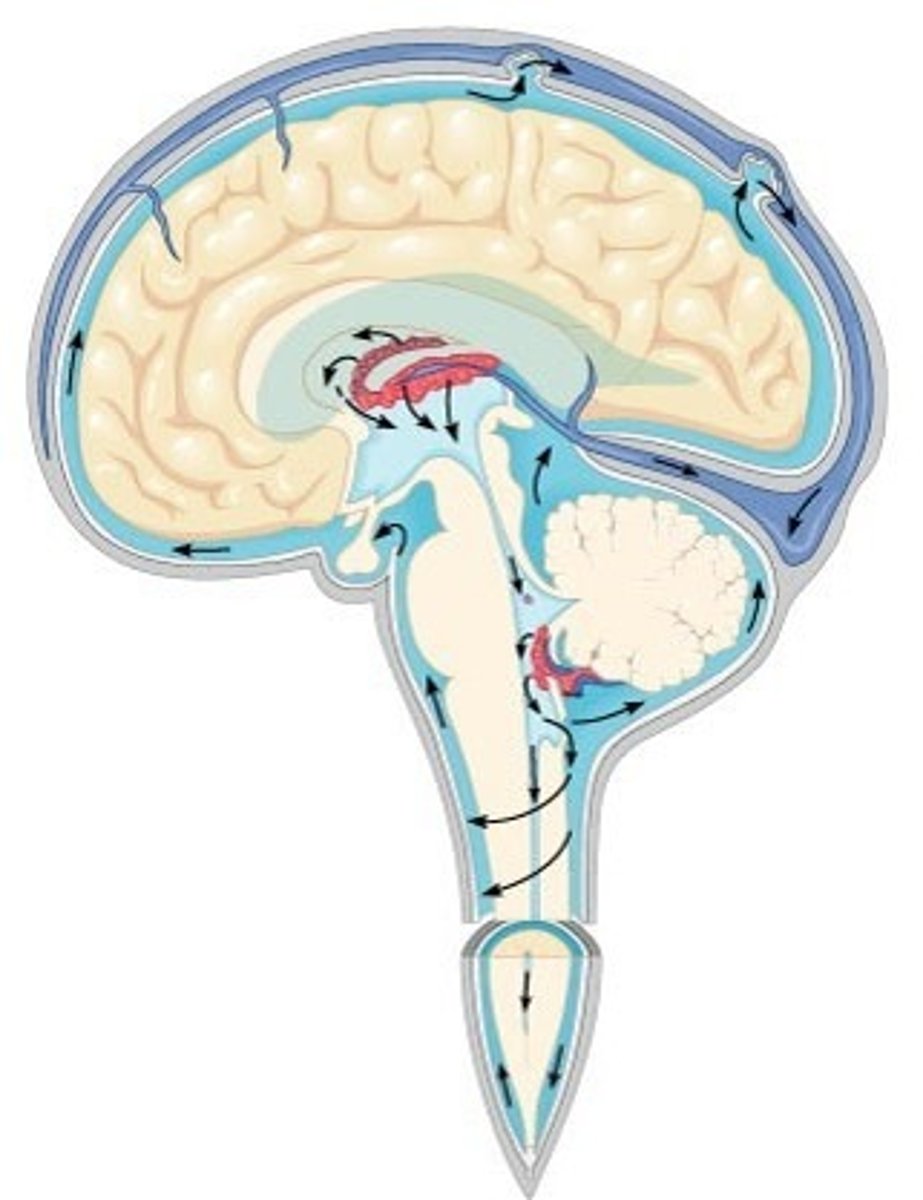
where does CSF exit
drains into the sub-arachnoid system and enters the venous system
what is the flow of CSF
produced in the chorid plexus
then goes to the subarachoid space (around the brain and spinal cord)
to the venous system (in the blood stream)
what causes CSF to be blocked
trauma, edema (swelling), tumors
what is a CSF blockage called
normal pressure hydrocephallus
what is normal pressure hydrocephallus
a type of reversable dementia
becomes reversable when you remove large amounts of CSF
what are the 3 symptoms of normal pressure hydrocephallus
1) declining memory
2) incontinece (not being able to control you bladder)
3) altered gait (you walk funny)
what does normal pressure hydrocephallus look like in a MRI
very large ventricles
corona radiata
white matter tracts that flow into internal capsule
if you had a stroke at the internal capsule, what would be effected
all motor comands
could become paralyzed
if you had a stroke in the cortex, what would be effected
only the specific motor movement damaged by the stroke
what could injuries in the cortex cause
cognitive impairments, language issues (aphasia), planning problmes (apraxia of speech), focal (specific) motor disorders
what could injuries in the corona radiata cause
(many) motor movement impairments on the contralateral side to where the stroke occured
an impairment of the working memory is impacted by
damage in the cortex
parkinsons happens due to injury of the
subcortex
not being able to understand speech is caused by an impairment to the
cortex
not being able to produce speech is caused by an impairment to the
cortex
if someone has paralysis to the right side without impairments of language or cognitive abilities it is injury of the
sub-cortex on the left side
deep brain stimulation (DBS)
electrical stimulaiton to deep areas in the brain (subcortex)
What does DBS treat?
parkinsons, tremors
thalamus
sensory relay station
has two left and right thalami
most medial of the subcortical structures
what are the two jobs of the thalamus
1) motor movements
2) sensory relay station
thalamus and motor movements between basal ganglia and motor strip
takes indirect (extrapyamidal) instructions to the cortex
this inhibits other movements from taking place (parkinsons is this on steroids)
thalamus and motor movements between cerebellum and the motor strip
takes "error corrections" from the cerebellum (balance) to the motor strip
sensory relay station
sends sensory infromation to the specific areas in the brain
all senses except for smell
what two diseases involve movement
parkinson's disease (restricted movement)
huntington's chorea (lots of movement)
Basal ganglia
collection of 5 nuclei that influences movement (does not cuase it)
where is the basal ganglia located
deep in the cerebral hemispheres and the brainstem
where does the basal ganglia receive information from
the cortex
direct pathway of basal ganglia
responsible for making all volunary movements
relys on dopamine to excite
basal ganglia is less involved (simplar)
indirect pathway of basal ganglia
responsible for preventing unwanted movements from hindering voluntary movements
relies on dopamine to supress movements
basal ganglia is more involved (complex)
what other structure does the basal ganglia inhibit
thalamus (limits its encouragment of movements)
what are the symptoms of Parkinson's disease
Bradykinesia
resting tremor
postural instability
Shuffling gait
What is bradykinesia?
slow movement
Symptoms of Huntington's Disease
Chornic movements
cognitive degeneration
psychiatric dysfunction
swallowing
how does one get Huntingtons
Genetically (50% chance of parent giving it to offspring if they have the disease)
3 key parts of the limbic system
cingulate gyrus
amygdala
hippocampus
what is the purpose of the limbic system
motivtation, emotional behavor, sexual drive, long term memory formation and retreival
what is the purpose of the cingulate gyrus
connects emotions with actions
Bridge between limbic system to frontal lobe
what is the purpose of the amygdala
fear and anxiety processing center
what is the purpose of the hippocampus
file clerk of memory, filling new inforamtion and retreving old memories, attention, and navigation throught space
what is another name for the hippocampus
seahorse
cortical spinal tract
on the top part of the cortex
contralateral
one nerve controls each specific movement
cortical bulbar tract
on the side of the cortex
bilateral
more protective since two nerouns control each thing
working memory (short term memory)
remembering temporary information long enough to make a decision or complete a task
declaritive memory
memory for factual information: names, faces, dates
where does decplaritive memory happen
in the hippocampus
procedural memory
A type of long-term memory of how to perform different actions and skills. Essentially, it is the memory of how to do certain things.
where is prodecural memory located
basal ganglia
Alzeimers
loss of declaritive memory
procedural lasts longer
eposodic memory
Memory of personal experiences of specific events in time the memories you fight over
what disease affects the hippocampus
Alzheimer's
cingulate gyrus
carries that limbic system's informaiton to the prefrontal cortex
what is another name for the cerebellum
little brain
what is the primary job of the cerebellum
smooth and accurate movements
what is the secondary job of the cerebellum
cognition, motor skills, language, attention, and emotional regulation
how many neurons are in the cerebellum
50% of the brains neurons
what is the % of volume that the cerebellum occupies
10%
where is the location of the cerebellum
in the skull base (posterior cranial fossa)
below cerebrum
posterior to the brain stem (by the 4th ventricle)
what level does the cerebellum opporate
at the unconscious level
what does the cerebellum detect
errors in movement
Is the cerebellum ipsilateral or contralateral?
ipsilateral
it has two hemispheres
no crossing over (the left hemisphere controls the left foot)
anterior lobe of cerebellum
forms the superior 1/3rd of the cerebellum
receives proprioceptive information
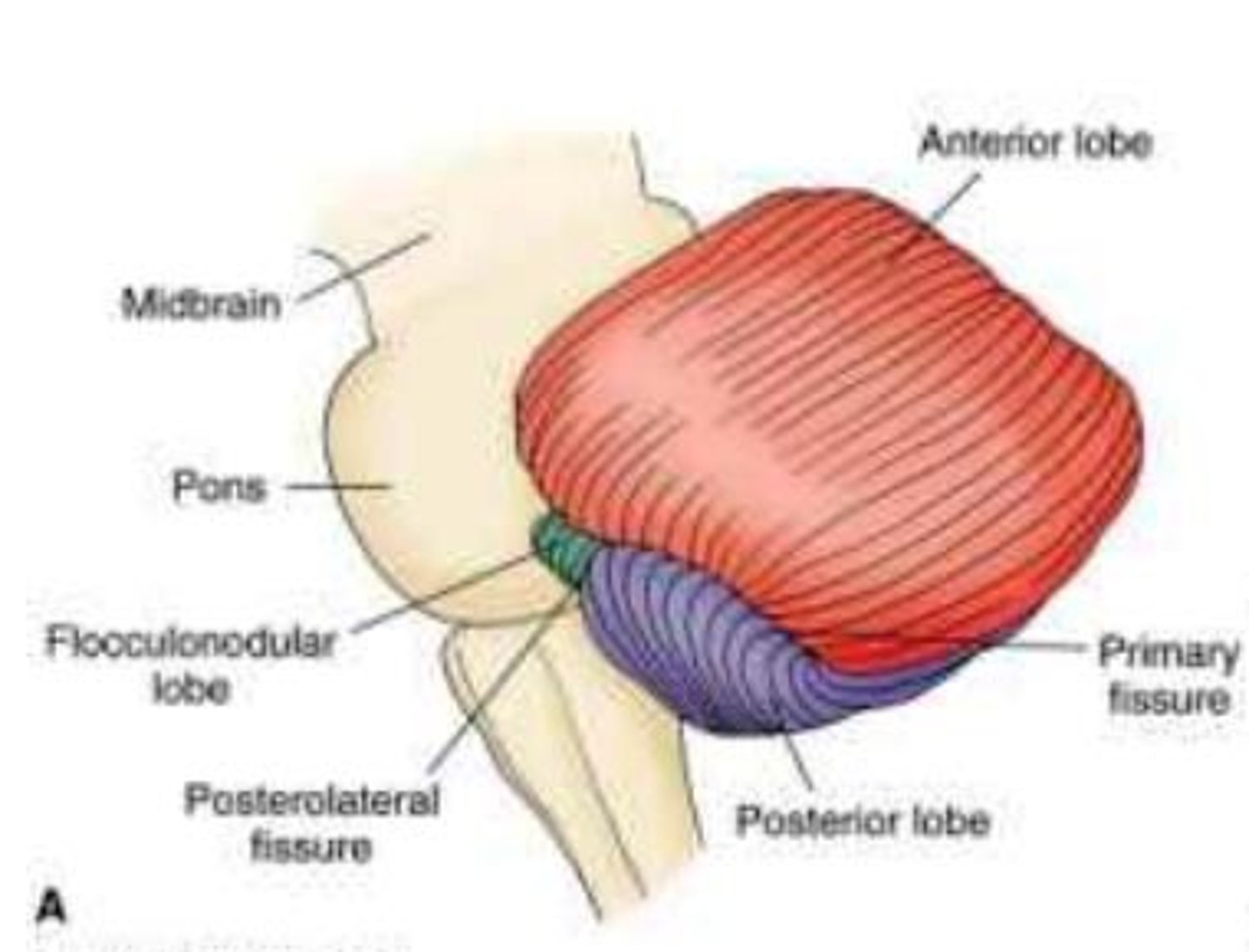
posterior lobe of the cerebellum
forms that inferior 2/3rds of the cerebellum and is further subdivided into lobules
controls widespread coordination, espicially lower extremities
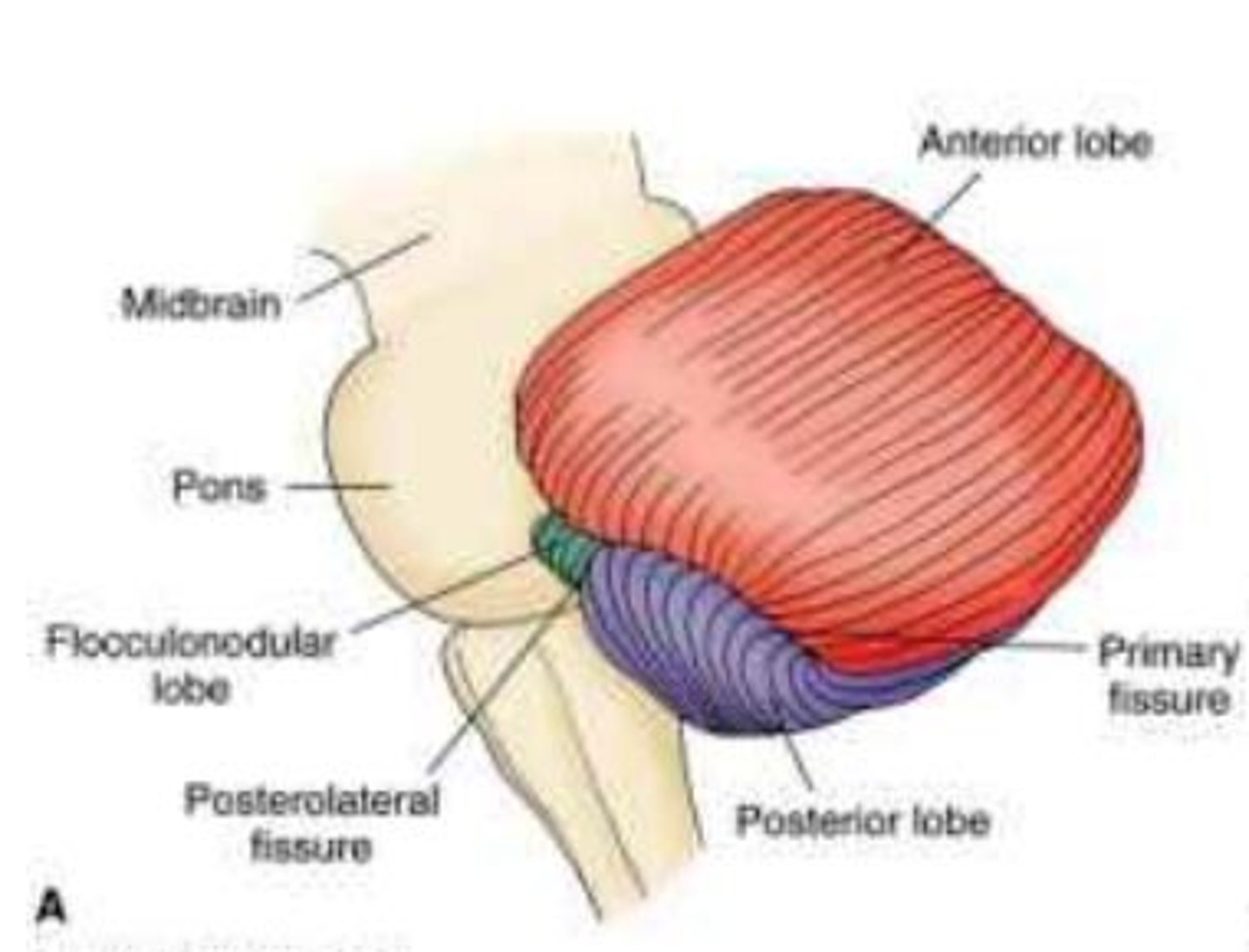
flocculonodular lobe of cerebellum
a smaller lobe tucked under the posterior lobe
receives information from vestibular system
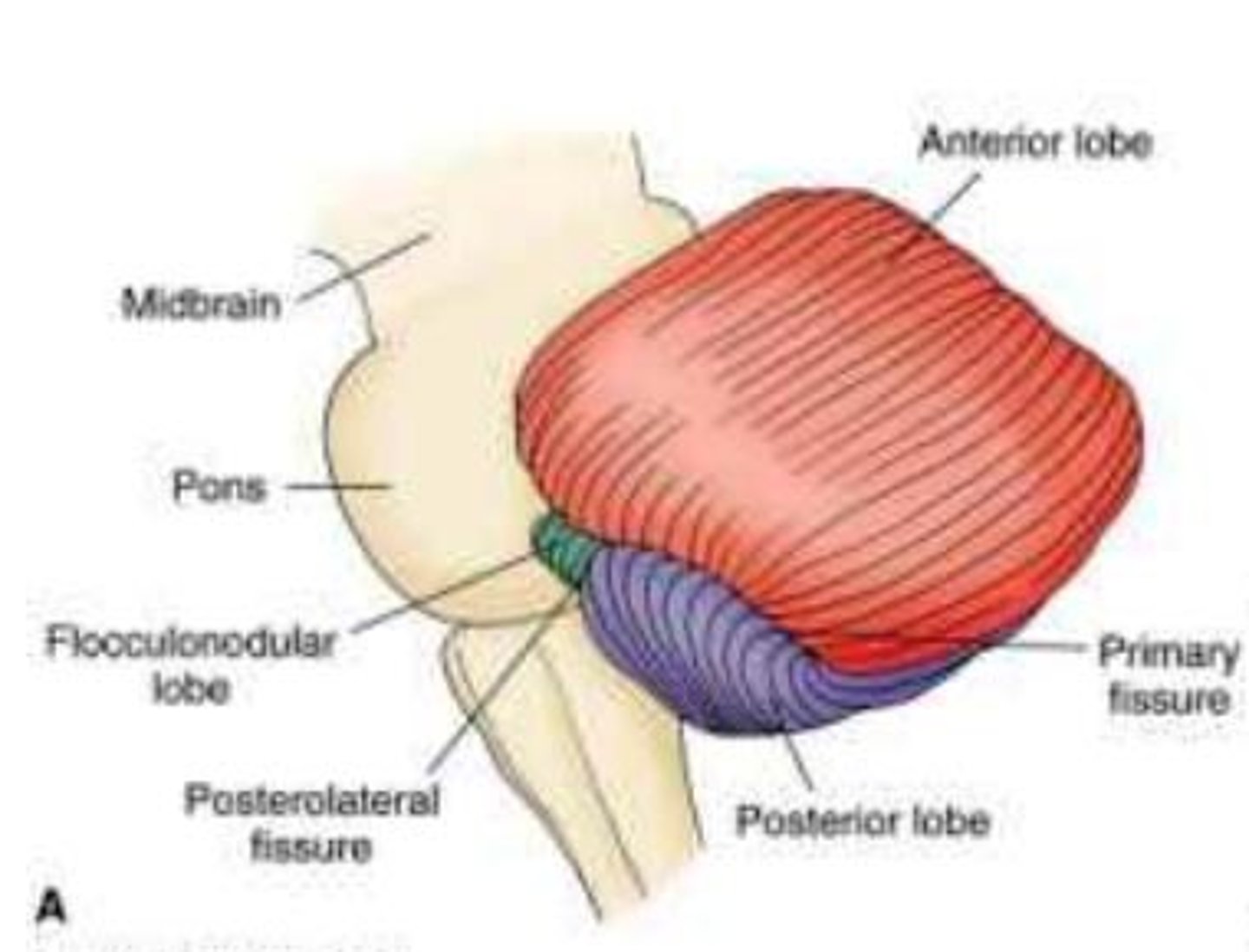
vermis of cerebellum
connects cerebellar hemispheres
looks like a worm
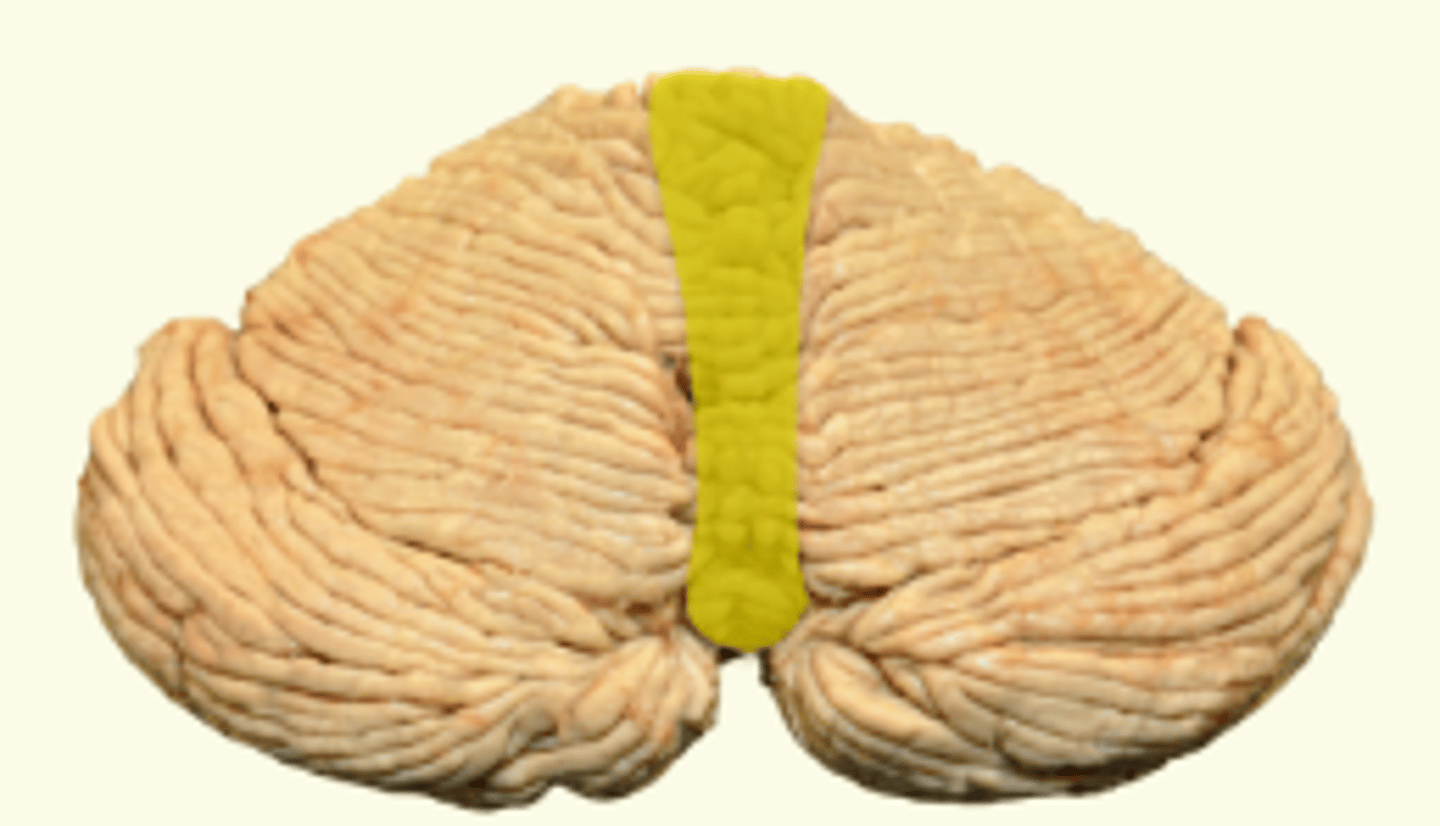
arbor vitae of cerebellum
white matter of the cerebellum; looks like branching fern when cut
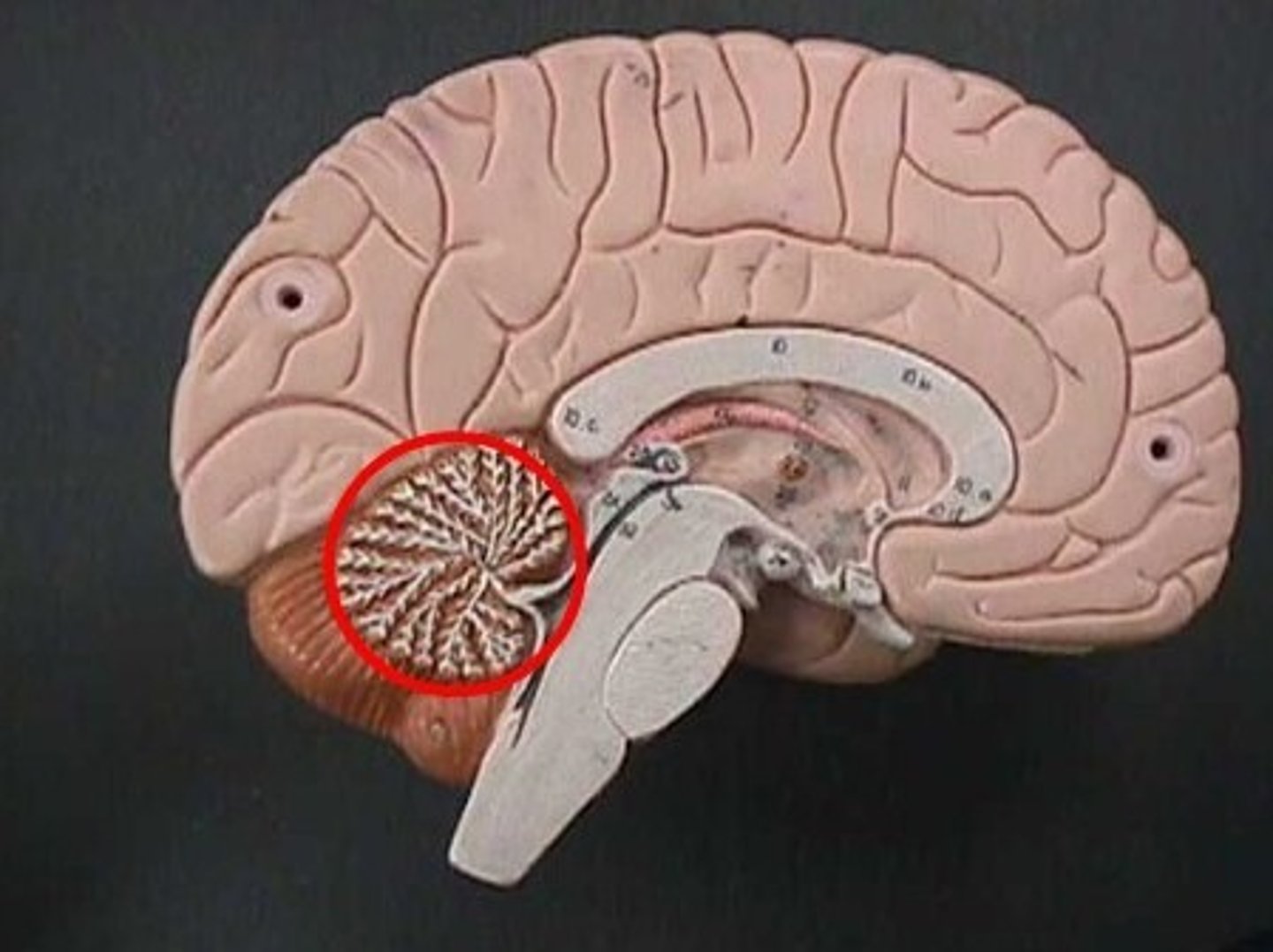
inferior cerebellar peduncle
connects the cerebellum to the medulla ablongata
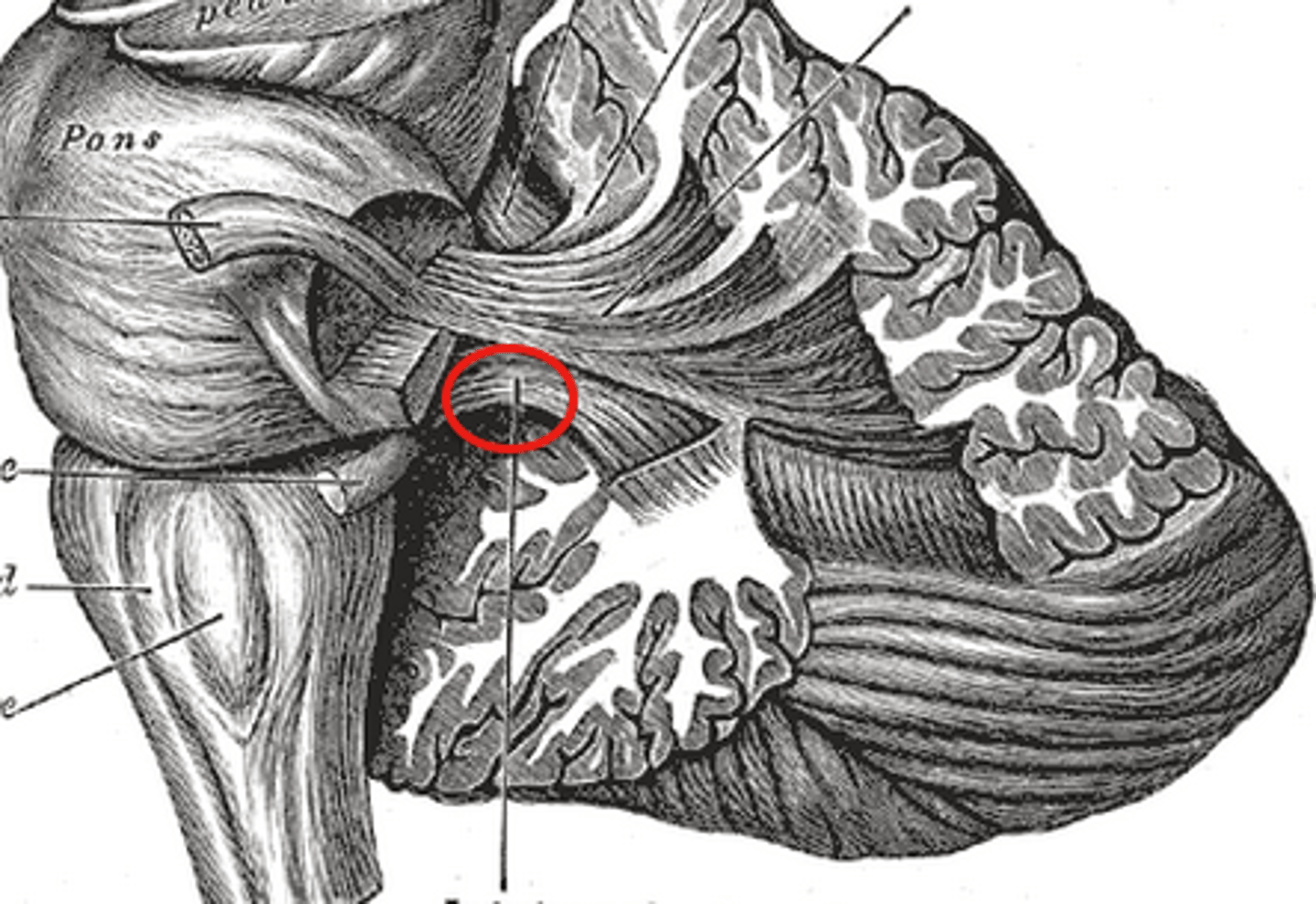
middle cerebellar peduncle
connects cerebellum to pons
longest of the three peduncles
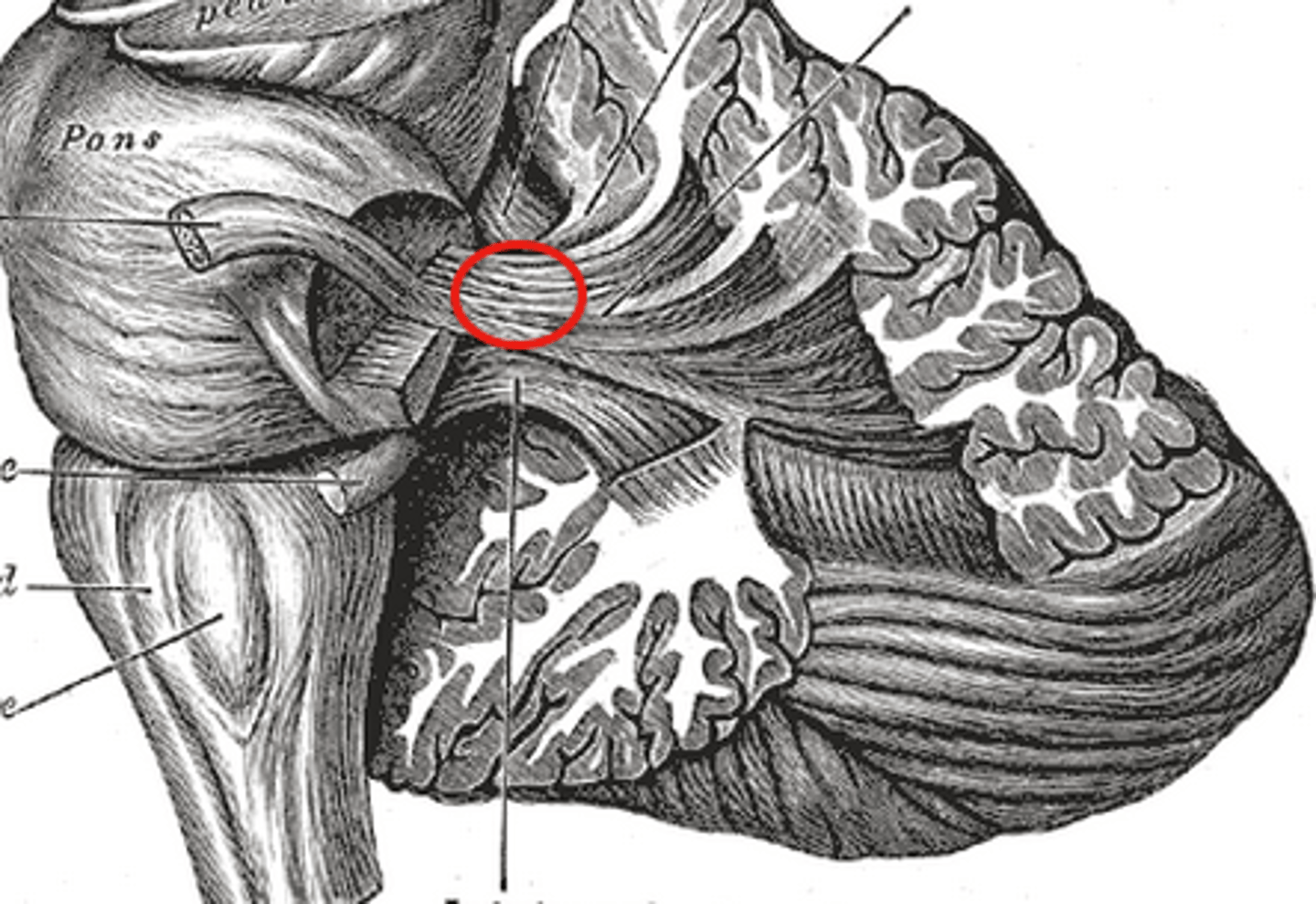
superior cerebellar peduncle
connects cerebellum to midbrain and to the red nucleus and thalamus
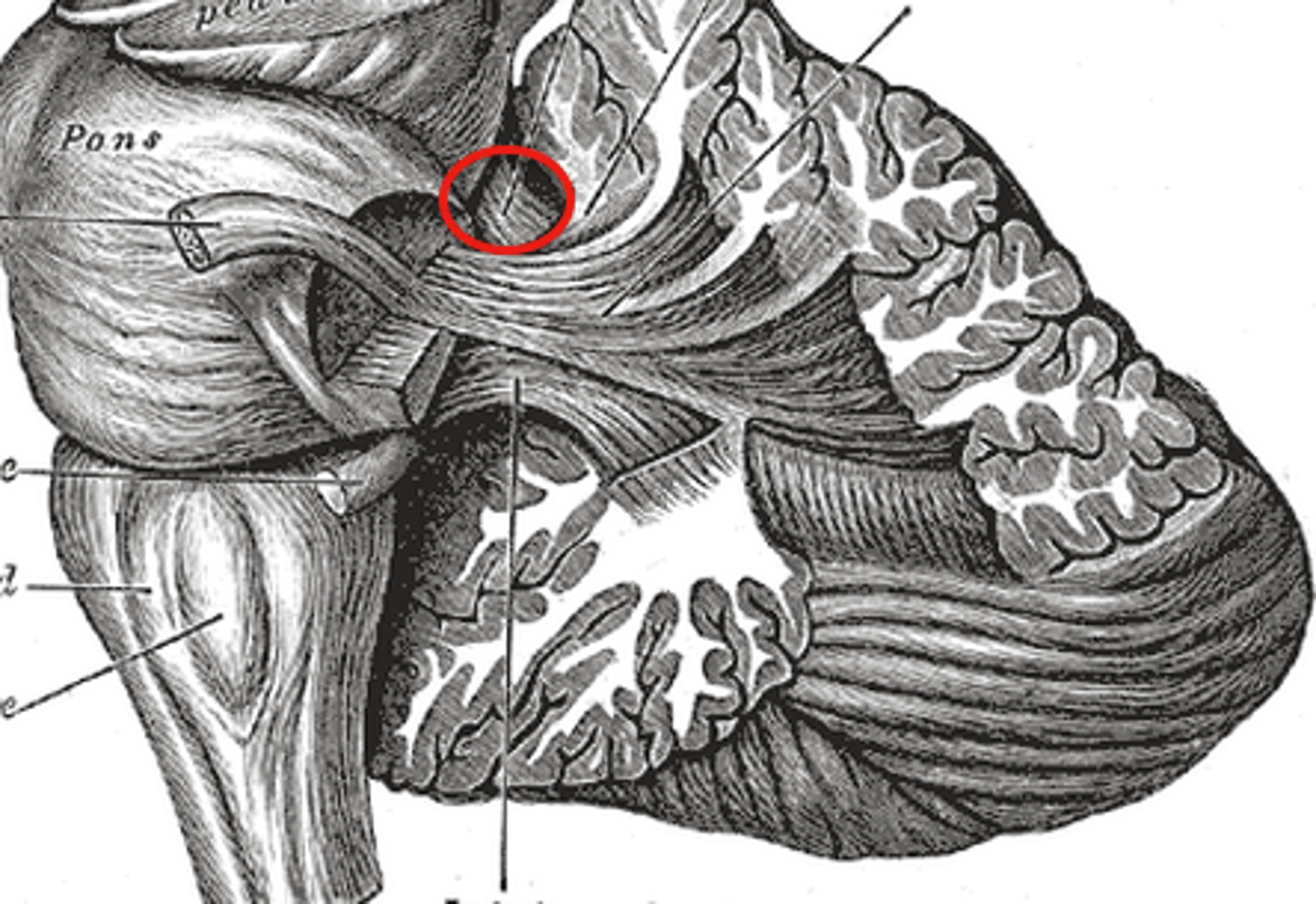
what are the three steps in the cerebellum motor plan
1) receives the motor plan (input)
2) provided with correct proprioception information from the body (input)
3) carries out adjustments/corrections to the motor plan (output to the cortex)
signs of damage of the cerebellum
ataxia, nystagmus, tremor, dizziness, dysdiadokinesis, dysarthria, dysmetria
what is ataxia
poor muscle control with movement
what is nystagmus
involuntary eye movement
what is dysdiadokinesis
inability to perform rapid alternating movements
what is dysarthria
motor speech disorder impact of execution of plan
what is dysmetria
overshooting, undershooting of movements
does cerebellum damage cause weakness
no
causes of cerebellar decline
degenerative diseases, tumor, trauma, stroke
how to recover from deep cerebellar injuries
typically they are long lasting, chronic, and not treatable
how to recover from superficial cerebellar injuries
they can improve with time and therapy
what is the difference between the cerebellum and the basal ganglia
cerebellum: controls ongoing adjustments, revision of the motor plan to achieve a smooth and accurate result
basal ganglia: controls timing and initiation of direct and indirect muscles/movements
what does innervation mean
brining nervous energy to muscles
contralateral innervation
providing innervation to the opposite side of the body (decussation)
what is neuro implication for contralateral innervation
a stroke in the right hemisphere will impact the left side of the body
bilateral innervation
providing innervation to both sides of the body
what is neuro implications for bilateral innervation
injuries to one side of the brain have less of an impact because there is two ways those muscles are getting energy
example of contralateral innervation
all spinal nerves (31)
example of bilateral innervation
most of the cranial nerves (except lower face and tongue)
corticospinal tract
decussates in the lower medulla at a location called the pyramids
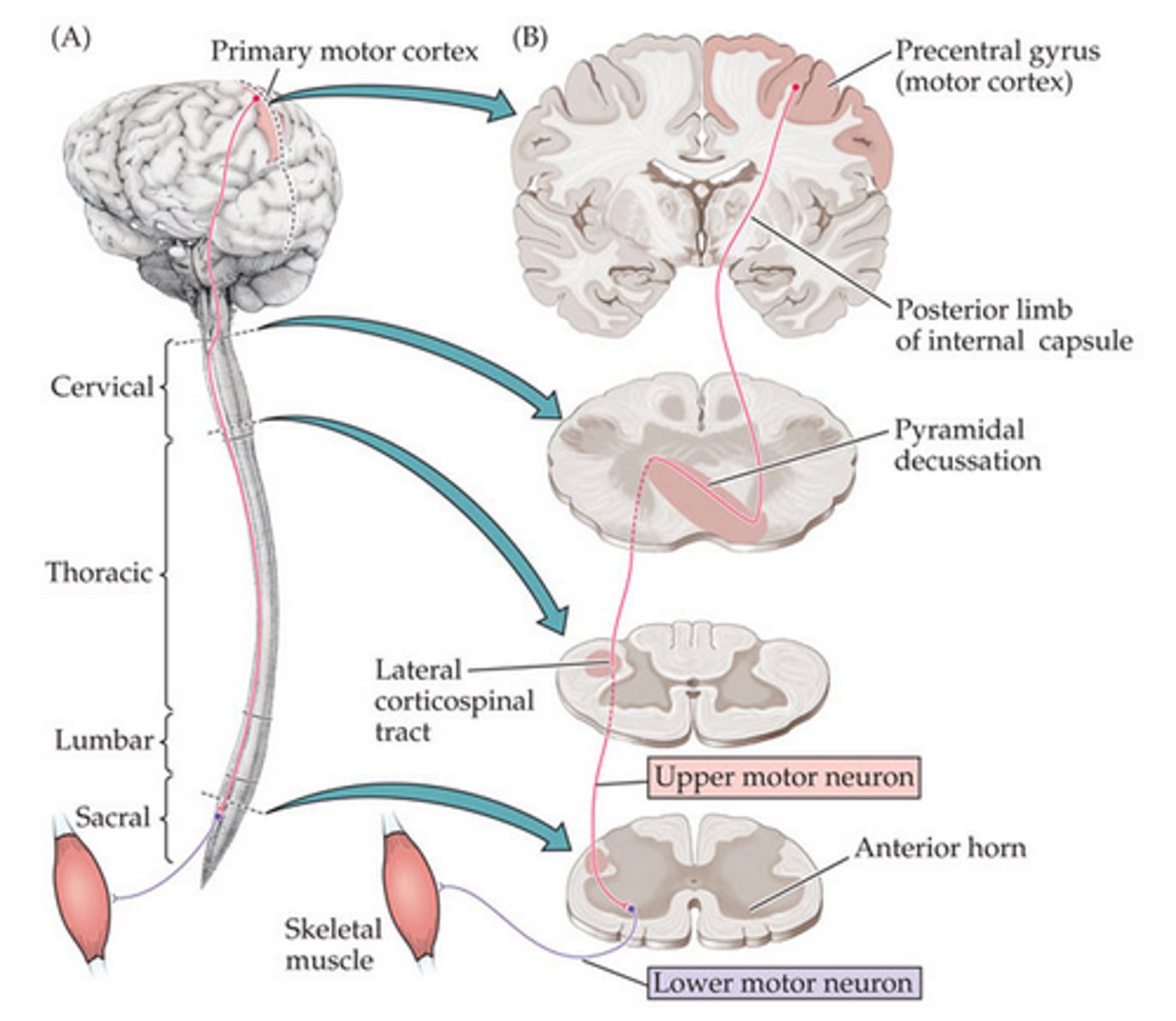
what % of fibers cross over in the cortiospinal tract
75-90%
what is the pathway of the cortiocspinal tract
IF YOU WANT YOUR RIGHT FOOT TO MOVE
message starts in the left hemisphere, then it travels on the corticospnal tract until it gets to the medulla where it decussates before going to the spinal cord
then it synapese with a motor neuron
corticobulbar tract
decussates just above the point of synapses with a cranical nerve
more complex (redundant than the corticospinal tract)
